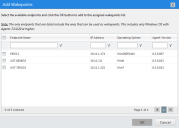Managing Wakepoints
Ivanti Wake on LAN uses wakepoints to send wake requests to network endpoints. Before you can begin waking endpoints, you must define wakepoints.
About Wakepoints
To power-on network endpoints, Ivanti Wake on LAN requires you to designate wakepoints. Wakepoints are endpoints that relay server wake requests to other network endpoints, thus waking them without a physical presence.
Ivanti Wake on LAN sends wake requests to wakepoints using the user datagram protocol (UDP). Wakepoints then relay the request to agent-managed endpoints.
Wakepoints disperse relayed wake requests through routers and firewalls. This avoids direct broadcast and multicast, which can cause excessive network bandwidth consumption. Additionally, routers may block UDP packets sent by other subnets. Successful wake request outcomes are contingent upon firewall and router settings.
Each segment of your network (VLAN) requires at least one wakepoint. However, Ivanti recommends assigning multiple wakepoints to each network segment. This practice ensures there are multiple distribution points within a network segment, therefore ensuring endpoints receive wake requests in the event that a router blocks a wake request.
Configuring Wakepoints
You should select wakepoints based on a managed endpoint's online status, installed agent version, and operating system.
Wakepoints must meet the following requirements:
-
Wakepoints must be Windows-based.
-
Additionally, Ivanti recommends that endpoints designated as wakepoints should always be powered on.
Important: You must select at least one Wakepoint within a network segment (VLAN).
Working with Wakepoints
Manage wakepoints from the Wake on LAN page WOL Configuration tab. You can perform the following tasks related to wakepoint management:
The Assigned Wakepoints list itemizes the currently selected wakepoints and provides you with options to add additional ones.
-
Select Tools > Wake on LAN.
The page opens to the WOL Configuration tab. -
From the Wakepoint Configuration section, add wakepoint(s).
Wakepoints are managed endpoints with the Wakepoint module installed. Wakepoints relay wake requests from Ivanti Endpoint Security to managed endpoints within your network.-
Under assigned wakepoints click Add.
The Add Wakepoints dialog opens.
-
Select the endpoints you want to function as wakepoints.
-
Click OK.
The Add Wakepoints dialog closes and the selected endpoints are added to the Assigned Wakepoints list.
-
-
From the Wakepoint Configuration section, edit the Wake on LAN Port (0-65535) if applicable.
This port is the port wakepoints use to relay wake requests to endpoints. When defining the Wake on LAN Port, remember the following:-
Under most network conditions, this field does not require editing.
-
Ivanti Wake on LAN uses 9 by default.
-
Ivanti recommends using 0, 7, or 9.
-
-
Click Save.
The changes to your configuration are saved.
The defined wakepoint(s) and port number are saved. The saved settings will be used during the next schedule wake request broadcast.
The Assigned Wakepoints list itemizes the currently selected wakepoints and provides options to remove wakepoints you no longer need.
-
Select Tools > Wake on LAN.
The page opens to the WOL Configuration tab. -
Within the Wakepoint Configuration section, remove the wakepoint(s) you no longer need.
-
Select the desired wakepoint(s) in the Assigned wakepoints list.
-
Click Remove.
A confirmation dialog displays. -
Click OK.
-
-
Click Save.
The changes to your configuration are saved.
The selected endpoint(s) are now no longer wakepoint(s).
Removing a wakepoint only prevents an endpoint from continuing to function as a wakepoint. It does not remove the Ivanti Endpoint Security agent from the selected endpoint.